How to Train A Cat To Go Outside (And Come Back)
Thinking of letting your cat explore the outdoors? Here's how to train a cat to go outside, come back safely & how a GPS tracker can help.
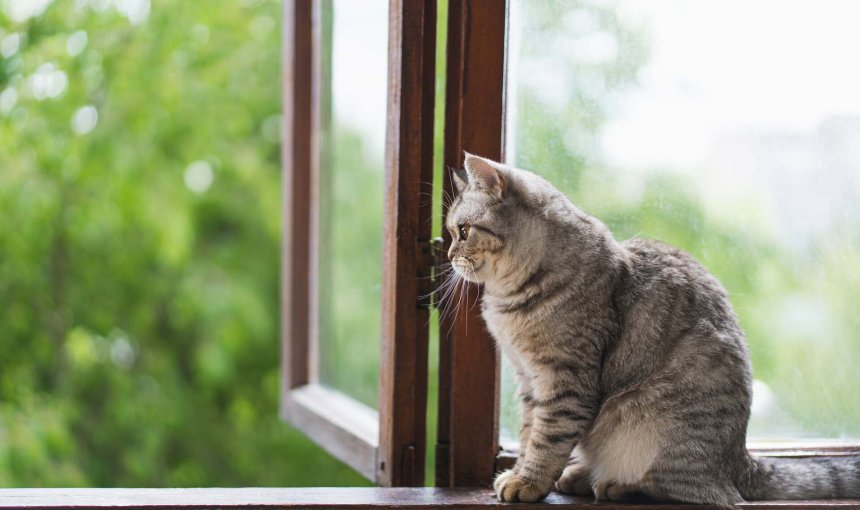
Whether they’ve been staring longingly out the window or you’re thinking of giving them more freedom, it’s totally normal to question how to train a cat to go outside and come back. But how do you keep them safe – and is it even ethical to have an indoor/outdoor cat? Let’s unpack everything you need to know how to train a cat to be outdoors and not run away. (And where a smart cat collar with real-time GPS tracking can give you the peace of mind you need.)
Key takeaways
🤔 Can you train a cat to go outside?
Absolutely. With steps like recall training, familiar paths, and routine.
😺 An indoor lifestyle works best for cats who are…
Timid, older, have health issues, or live in high-risk areas like cities or busy roads.
😼 An outdoor lifestyle offers stimulation and enrichment…
But also comes with greater risks like accidents, illness, and getting lost.
⚖️ The indoor-outdoor compromise – like leash walks or enclosed catios – can offer the best of both worlds for many cats.
🌎 Finally, a smart cat collar like Tractive is a must-have for outdoor or adventurous indoor-outdoor cats, giving you real-time GPS location tracking and escape alerts.

Find out where your cat spends their time.
Read moreCan you train a cat to go outside? And should you?
Short answer: yes. With the right approach (and a bit of patience), you absolutely can. Cats are natural explorers. But in today’s world, the outdoors can be a minefield – from traffic to toxins to territorial wildlife. That’s why more and more pet parents are asking: “Can you train a cat to go outside and not run away?”
Letting your cat outside can satisfy their wild instincts – chasing leaves, climbing trees, basking in the sun, and exploring new scents. This kind of stimulation can be wonderful for cats with strong hunting instincts or those who seem bored or frustrated indoors. It’s also a natural choice in rural areas with lower traffic and plenty of safe, open space.
However, keep in mind the risks as well. Outdoor cats face potential threats like cars, aggressive animals, toxic plants, parasites, getting stuck in weird places (like garages, cars, or cellars), and even theft. They may get into territorial fights, pick up illnesses, or wander too far and lose their way. Additionally, outdoor cats have a shorter average lifespan compared to their indoor counterparts.
Is the outdoor life a good fit for all cats?
| Outdoor life might be a good fit for… | Outdoor life might not be ideal for… |
|---|---|
| Cats with strong hunting instincts | Timid or anxious cats |
| High-energy cats that get bored easily | Cats with health issues or disabilities |
| If you live in rural/low-traffic areas | Cats living near busy roads or cities |
| Cats previously accustomed to outdoor access | Young kittens or senior cats |
| Cats with access to secure outdoor spaces | Cats prone to getting lost or disoriented |
💡A smart cat collar that lets you track your cat’s movements in real-time can be a lifesaving emergency measure if you’re thinking of letting your cat outside. We’ll cover it in detail a little further below.
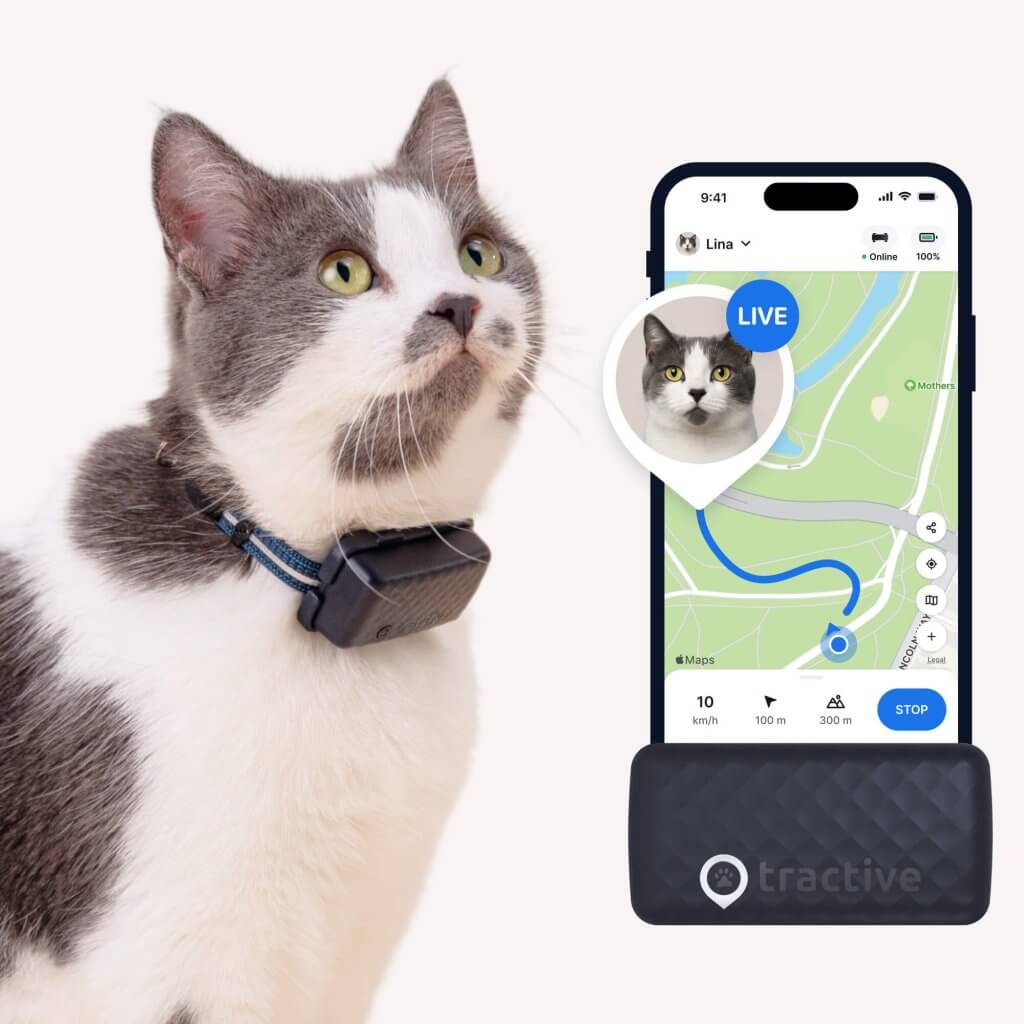
Track your cat wherever they go
Get real-time location information, wherever they go. Find out when they go somewhere they shouldn’t, with Virtual Fences. And discover their favorite spots with Territory.
Is it cruel to turn an outdoor cat into an indoor one?
Not at all – if you’re thoughtful about the transition. While it might seem like you’re taking something away, moving an outdoor cat indoors can be one of the most loving, protective choices you make. (Especially in areas with heavy traffic, extreme weather, or frequent wildlife encounters.) Cats are adaptable creatures. With the right support, most cats can successfully transition to indoor life and thrive. The key is making sure their new environment is just as stimulating and satisfying as the great outdoors. Go for:
- Vertical space with shelves and cat trees,
- Puzzle feeders and toys,
- Keep windows accessible for bird-watching
- Add regular interactive play sessions to help them burn energy
That said, the adjustment can be a challenge, especially for cats used to total freedom. Some may show signs of stress, like pacing, meowing at doors, or scratching furniture. These behaviors typically ease over time with consistent enrichment and patience. In some cases, the indoor-outdoor compromise – like supervised walks or a secure catio – can help make the transition smoother.
Ultimately, turning an outdoor cat into an indoor one isn’t cruel. It’s about replacing the risks of outdoor life with a safer, enriched alternative that still respects your cat’s natural instincts.
How to train a cat to go outside (and come back)
1. Start slow and supervised
Begin by choosing a calm, quiet time of day – ideally when there are fewer distractions like dogs, loud cars, or children playing. Let your cat explore a small, enclosed area like a fenced backyard, patio, or balcony.
Use a well-fitted harness and leash to give them a sense of security while keeping them under control. If your cat has never worn a harness before, give them a few days to get comfortable with it indoors first. Once they’re outside, sit with them, talk gently, and let them sniff and observe at their own pace. Keep these early sessions short – just 5-10 minutes – and always end on a positive note. Offer treats, pets, or playtime after heading back inside. This teaches your cat that the outdoors is part of a fun and rewarding experience shared with you.
The key here is consistency and patience. Some cats might take to it quickly, while others may need several days – or even weeks – before they feel confident outdoors.
2. Teach your cat to come back when called
Start by choosing a consistent cue – a word like “here,” a whistle, their name, or the shake of a treat container. Use this cue every time you want your cat to come to you, both indoors and outdoors.
Begin practicing indoors where there are fewer distractions. Call your cat using your chosen cue and reward them immediately when they respond. Once they’re consistently coming to you indoors, you can start practicing outside in a controlled area, like a fenced yard or on a leash.
Make sure to only call your cat when you’re ready to reward them with something positive. (And never to scold or interrupt a fun moment.) Keep training sessions short, upbeat, and filled with pats, praise, and treats. Over time, your cat will associate the recall cue with good things, making them far more likely to return when called – even if they’re off exploring.
Read more: Cat Clicker Training: Tips, Tricks & Best Practices
3. Let your cat out around the same time
Set a specific time each day for your cat’s outdoor excursions – early morning or late afternoon often work best when it’s quieter outside and temperatures are more comfortable. Start by opening the door at the same time daily and using a verbal cue or sound (like a clicker or bell) to let your cat know it’s time for outside. Over time, they’ll begin to associate this sound and time of day with their supervised adventure.
While your cat is outside, keep each session to a predictable length – 15-30 minutes is a good start. You can gradually increase both the time and their range as they build confidence and show reliability in returning.
4. Set up your home so your cat can go in and out safely
One popular solution is installing a cat flap or pet door. These allow your cat to come and go independently. You can opt for a basic model or go for an upgraded version that only unlocks for your cat’s microchip or collar tag – keeping neighborhood strays and other wildlife out.
When installing a cat flap:
- Choose a secure location with visibility and shelter (like a side door or garden-facing wall).
- Start by showing your cat how to use it with treats or toys.
- Practice opening and closing it manually until they get used to the motion and sound.
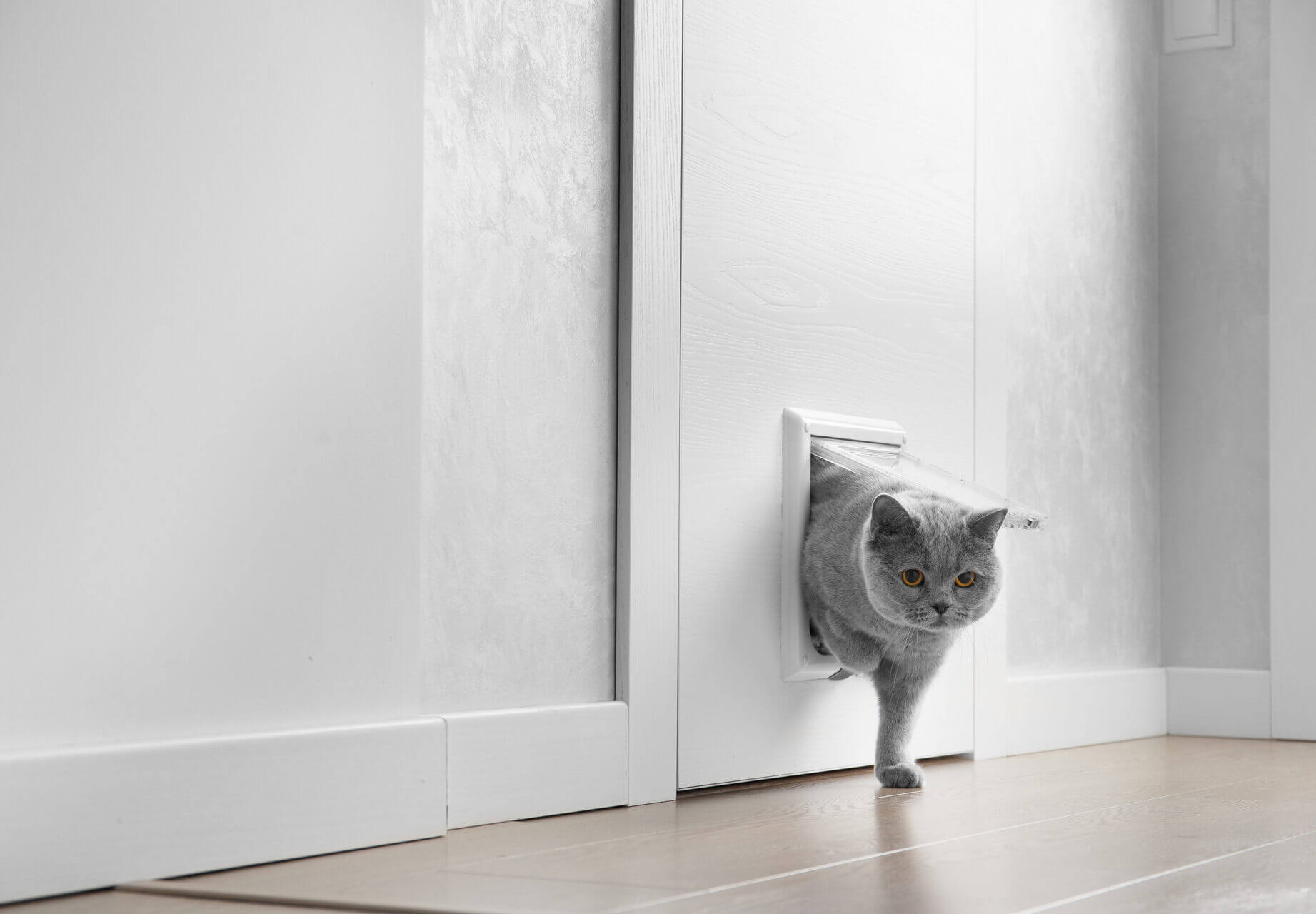
If a cat flap isn’t an option, you can also designate specific windows or doors for supervised access. In this case, make sure there’s a clear route to their entry point. Keep the area clutter-free and safe and make sure you train them to return at certain times (like before dark or meals). Adding a doormat, soft blanket, or sheltered box near their entry point also gives them a safe space to pause and rest before heading back indoors.
5. Know when to let go (of the leash)
Start by allowing short off-leash sessions in a secure, enclosed yard or very familiar, low-risk area. Make sure these first free-roam moments happen when you’re nearby, so you can observe and intervene if needed.
Look for signs your cat is ready: Do they stay close to home base? Come back promptly when called? Check in with you during outings? If yes, you can gradually extend their time and independence. But if they wander too far or seem distracted or fearful, it’s okay to step back and return to supervised training.
Remember, some cats – especially those in urban environments or with anxious personalities – may always be safest (and happiest) on-leash or within a secured outdoor enclosure. And that’s perfectly fine. The goal isn’t full independence. It’s about giving your cat enriching experiences in a way that feels safe and manageable for you both.
This is also the perfect time to ensure your cat is microchipped and wearing a GPS tracker like Tractive. That way, even if they take a wrong turn or stay out longer than expected, you’ll always know where they are – and how to get them back safely.
6. Stick to familiar paths
Encourage your cat to follow the same route during each outing – around the same bushes, past the same tree, or along the same garden path. This repetition helps them feel secure and reduces the chance they’ll get disoriented or wander too far. Avoid making sudden changes to their environment if possible, and introduce new areas slowly and one at a time.
Cats rely heavily on scent, routine, and their internal sense of territory. When first exploring the outdoors, they create mental maps of their environment, using landmarks and scent trails to navigate. That’s why it’s important to stick to familiar paths and areas during the early stages of training. If your cat seems hesitant or nervous about a particular route, don’t force it. Let them take the lead and choose their pace. You can guide them gently with treats or toys, but never rush the process.
Eventually, your cat will establish a territory they feel safe in. As they grow more confident, you can gradually expand their roaming area – but always with awareness of the surroundings and your cat’s comfort level. A smart cat collar can help you track these familiar paths and monitor how far your cat typically roams, giving you peace of mind along the way.
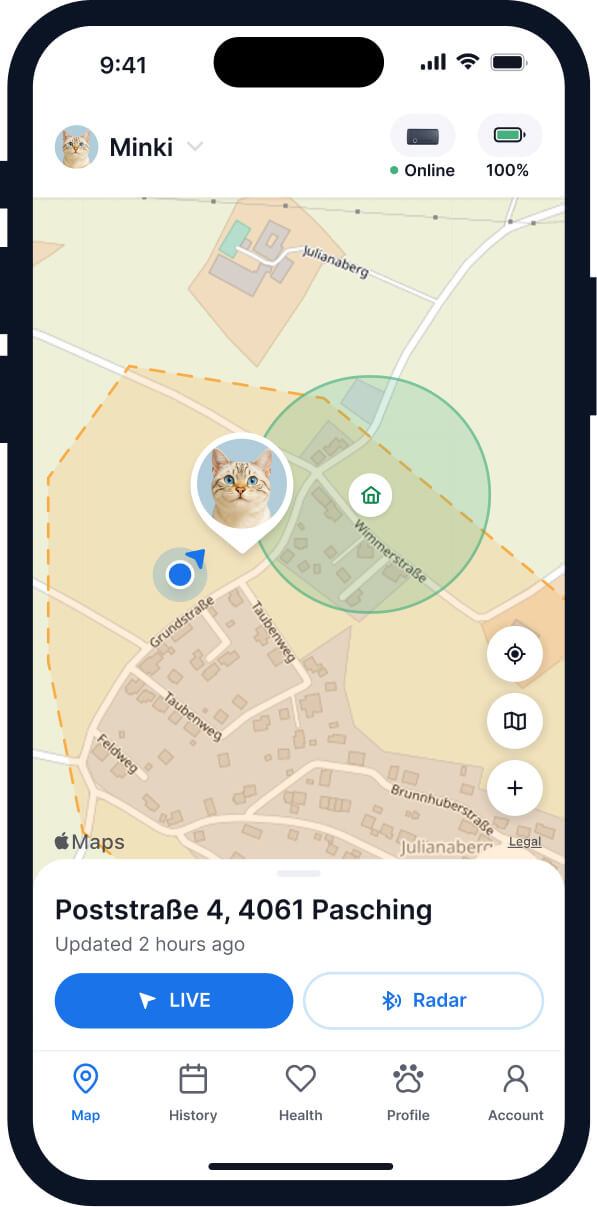
Finally, make sure every outdoor experience feels rewarding for your cat. Bring toys outside, toss a few treats, or give lots of praise and petting when they return to you. The more they associate you – and your home – with comfort and good things, the more likely they’ll come back happily.
Read more: How To Design A Cat-Friendly Garden Your Neighbors Will Envy
Where a smart cat collar can step in as an emergency measure
Even the most obedient, well-trained cat can have an off day. They might get startled by a loud noise, chased by another animal, or simply follow their curiosity a little too far. That’s when a smart cat collar with real-time GPS tracking stops being a nice-to-have – and becomes essential.
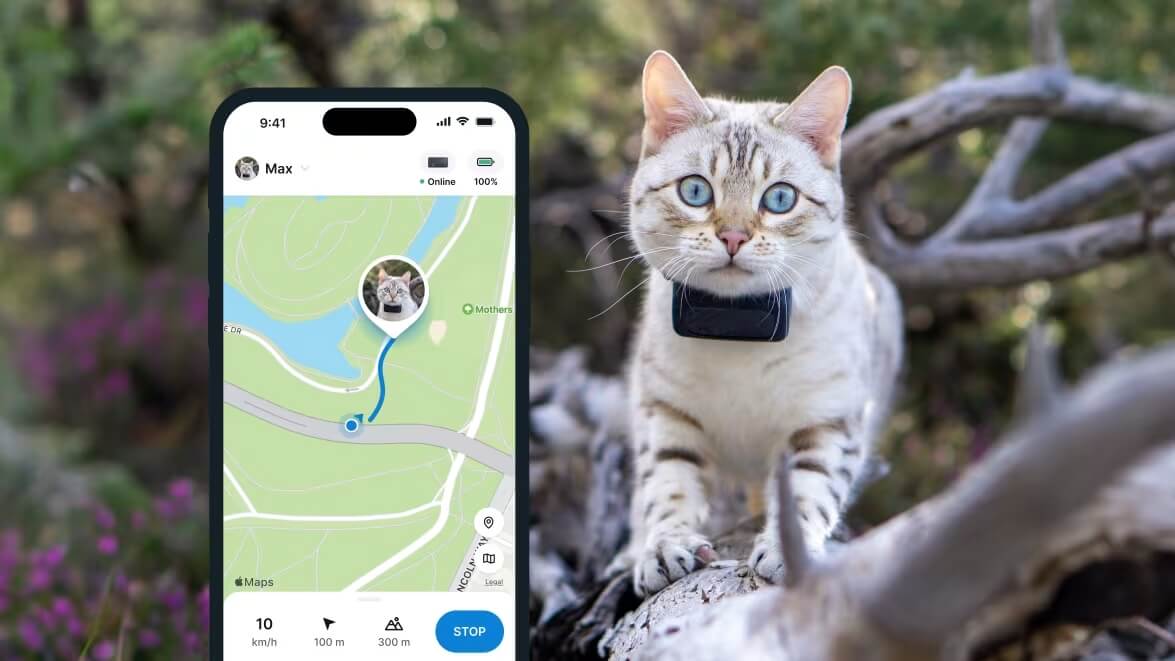
Strapped to your cat’s collar, your trusty Tractive device helps you:
- Figure out your cat’s location in real-time
With LIVE tracking, you can see exactly where your cat is, anytime – down to the slightest movement. So the minute your cat disappears from sight or into the underbush, you’ll know where they are. - Catch on to an escape attempt much in advance
From your Tractive mobile app, you can set up a “safe zone” around your home or backyard. (Or a “no go zone” around that busy street down the block.) Now the minute your cat tries leaving a safe zone or entering a no go zone, you’ll get an escape alert to your phone. So you can act quickly before they venture too far. - Figure out your cat’s territory
Through your cat’s Heat Map and Location History. So you’ll know your cat’s favorite routes, hiding spots, and roaming patterns. This info can be especially helpful in an emergency, guiding your search if your cat doesn’t come home as expected.
And the best part? Tractive trackers aren’t limited by range or a network of compatible devices to work. (Like Apple AirTags.) Rather, a cat GPS tracker works like a digital safety leash. It won’t stop your cat from being adventurous – but it will help you stay connected, informed, and ready to act if things go off track.



